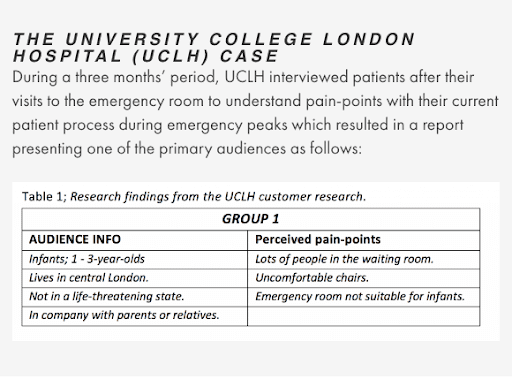“A marketing persona is a composite sketch of a key segment of your audience. For content marketing purposes, you need personas to help you deliver content that will be most relevant and useful to your audience.”—Ardath Albee
If you’re involved in business, you’re all too aware that you need customers to survive and thrive. You may also be well aware that reaching them, engaging them, and getting them to purchase from you and tell others about you can be enough to drive you around the proverbial bend.

You’re likely a consumer, too, after all. You know the marketing that leaves you cold. Or worse, you know that feeling of being so annoyed by someone’s mis-marketing that you go out of your way to unsubscribe or block them, no matter how much time it takes. (Wait, is that just me??).
Every once in a blue moon, though, you come across content that tickles. That delights you. That gets who you are and what you need. It feels like it’s being created for you, and for you alone. “They know me!”, you may be tempted to shout out, dancing in the streets. (Hm, or that one may well be just me again.)
Examples of content that nails it:
This Extra Gum Commercial (I mean really, what’s fresh smelling breath for, if not for running through the city and having post-pandemic park orgies?)

Subaru, you get me.

Dinner without ketchup, anyone?
WWF makes an emotional impact:

Good Personas Matter
Even if no shouting out or dancing is involved, it’s pretty darned nice to meet someone—even if it is a brand—who lifts your spirits for a moment in a way that delights, informs, or speaks to you like the amazing person you are.
As a brand marketer, this is exactly where good personas come in.
Note that I say good personas. Not those bland “Savvy Sara: an 18-25 year old student of nursing who who enjoys line dancing and long walks on the beach.” (Who is that person, anyway?)
Today we want to get you so clear on who you’re speaking to, what they love, want, need, loathe and believe in, that you can actually truly reach them. Delight them. Bring them into your brand family by virtue of empathy, compassion, and knowledge.
Speak to the segments—but get to know them as people
Back when I was in magazine publishing, I had a mentor who taught me that defining your audience is at least as much about identifying who you do NOT want to reach as knowing who you do.
The upshot: you are not trying to reach everyone. You’re after a segment of the population out there, hoping to ease one or more of their pain points, and/or to make their lives better in some way with your products or services.
Just please take note that personas are not quite the same as audience segments.
OK, so exactly what are personas vs. audience segments?
Personas do signify or stand for groups of your real customers, but are generally used differently. We look at personas as fictional people (based on your data, stats and stories) who each represent people you as a business want to connect with. Each persona should represent a unique set of values, questions, and pain points relating to your products or services.
In content marketing (and sometimes in design) personas are used as characters who help creators to better understand and naturally speak to fully-fleshed humans with known needs—NOT demographic clusters. You can’t make good jokes to demographic clusters. You can’t build much trust among demographic clusters. You can do those things with real people, though.
When done well, personas help you understand what someone needs from your content, product or service; what might motivate them to learn more and/or buy from you; how they behave in various stages of the buying process; and what kind of voice, design, channel, content type, etc., will best engage them.
The Importance of Story
First, read this excellent post by Mark Anderson about how to use personas for audience research—in his case, to design better user experiences. In the post, he tells us that he often uses this example to spell out the differences between a blah persona and a story that moves people to action. First, check out the first example:

Then, Mark invites us to consider the story of a 3-year-old girl named Joyceline who had to wait almost four hours in an emergency room with a broken hand before getting to meet a doctor.
Right. The two examples represent exactly the same audience segment and pain points—but Mark notes that “when comparing the number of suggestions to how the hospital could improve their patient process” when presenting the the Joyceline story vs. the first Audience Info table, the number of suggestions is about twice as many and the perception of urgency is significantly higher.
Stories in general—and stories applied to personas, too—humanizes data. Like any good story, a good persona story should provide rich details that allow us to connect and relate on a human level to the fictional person that is representing an audience or customer group.
What makes good personas extra good? Sometimes it’s identifying the bad.
As the fabulous Ann Handley of MarketingProfs notes in her excellent post, “How to Repel the Wrong Customers and Attract the Right Ones, “It’s a waste of time and resources to nurture relationships with people who are a bad fit for your business. It makes your nurturing programs seem far less robust than they actually are.”
Hubspot even recommends creating exclusionary (aka negative) personas if you repeatedly find yourself wasting time and money marketing to a segment that ultimately never buys from you, or that costs too much to acquire. In most cases, though, you can simply ensure that you ask questions that get to the heart of who you don’t want to reach or engage along with getting clear on who you do.
Great. So where do I start?
With our clients, we always take time to identify and understand the broad groups of people being served. If you’re a business owner or leader, you’ll likely have a pretty good idea of these customer or audience ‘buckets’—or could begin by looking through your customer databases, website and/or social media data, to start sorting.
Use the analytics tools built into social platforms to see who you’re already reaching and engaging well, and look at your Google Analytics to see who’s coming to your site from social. A little detective work in this way will begin to show you your existing audience online—and might reveal some gaps, too.
Don’t fret if you don’t have this nailed down yet: you can learn about your audience in LOTS of ways, from conducting customer surveys or focus groups to taking an SEO-first look at your existing readership or audience (the folks at SEM Rush outline this in solid detail) to going deep with audience segmentation in Google Analytics.
“Just 3 to 4 buyer personas usually account for >90% of a company’s sales.”
Mark Schaefer
The next step: break this large group down into sub-groups (try for 3-5) by asking a few of the following questions:
- What does success look like for each group, should they work with/buy from you?
- What specific problems is each group struggling with?
- How do you as a business solve their problems or relieve the pain?
With just these questions, you’ll begin to sketch out—naturally, we hope—your broad audience groups, based not only on demographics, but on how they’re trying to resolve the challenges that you can best help with.
The next task: prioritize ‘em. Who is most important to your business? Is there a persona you must reach or engage to reach your most important business goals? Start there.
If you’re just starting your persona process, we recommend starting with a single persona, or up to three at most. In most cases, we like starting with a current ‘ideal customer’—someone you’d like to clone, if you could. Then ask them your version of these questions.
What I mean by that is simply this: you don’t need to find out where they live if knowing that isn’t relevant to your business, or your content. And if something is vitally relevant to your business or content, find out.
You can ask them directly in a survey (Google Forms, Typeform, perhaps) or answer based on your experience.
20 QUESTIONS WE LOVE TO HELP CREATE THE RIGHT PERSONAS
MOTIVATIONS / JOBS TO BE DONE
- What’s the persona trying to achieve, when they come looking for a product or service like yours? Include several bullets if you need to, to ultimately identify the one primary Job To Be Done (JTBD) that this persona is trying to tackle.
- Why are they looking for a solution now?
- What challenges are they up against in trying to accomplish their JTBD?
- What might they type into Google along the way to accomplishing their JTBD?
- What might happen if they picked the wrong solution, or did nothing?
DEMOGRAPHICS
- What’s your ideal B2C customer like? (if applicable)
- Age?
- Where do they live?
- What gender do they identify with, if any?
- Occupation?
- Do they have kids? If so, how many and what are their ages?
- What is their marital status?
- Personal or household income?
- Education level?
- What’s your ideal B2B customer like? (If applicable)
- Where do they work?
- What’s their title or role?
- What was their career path like?
- What industry are they in?
- How many employees are in the company and/or what are their revenue numbers like?
- What does their buying process look like? Is your persona the decider, or what role might they play?
- What does a typical day look and feel like for them?
- Who is their boss and what is their relationship like? Do they manage others?
- How do they, and how does their company, measure their success?
MINDSET & BEHAVIOUR
- Why might they want to buy a product or service like yours?
- What are their main considerations in choosing this kind of product or service?
- What kinds of things might they dislike or even hate about products or services or vendors like you?
- What are the main drivers in their decision-making process?
- What might make them hesitant to buy?
- Which competitors or other options might they consider? (Doing nothing might be an option, for example.)
- Where are they spending time online?
- What content are they most interested in? (Do they read blog posts? Watch videos? Listen to podcasts?)
- Note any events or conferences they have attended.
- Do they have any relevant pastimes, hobbies, or habits?
NEGATIVE PERSONA INFORMATION: WHO YOU DON’T WANT
- Are there any kinds of customers too expensive or challenging to serve/support?
- Are there customers who don’t have the budget for what you offer, or for whom your product/service is not suited?
PRIORITIES
- On a scale of 1 to 10, how important is this person to your business success?
AND A FEW HELPFUL TOOLS FOR CREATING PERSONAS
Once you’ve gathered some answers, you can play around with how to present your personas. A plain old table in a Word or a Google Doc can work just great. You can try using some of these tools, as well, to play around a little — these are all free tools that help you to flesh out who you need to reach, what they care about, why they might hesitate about considering your brand, and critically, how to get in front of them.
Wherever you start with developing your brand personas, just remember that you’re out to better understand your audience so that you can better communicate with them, human to human.
Reach out if you need support with your persona creation, or with creating the perfect content to reach and engage them. We’re always right here.













